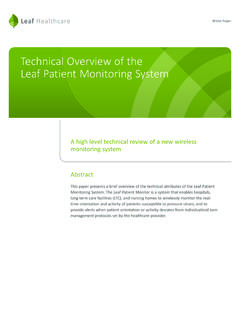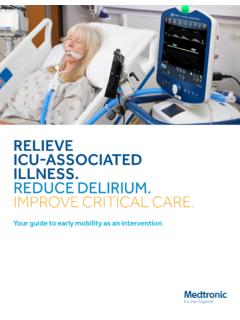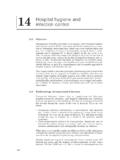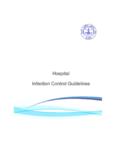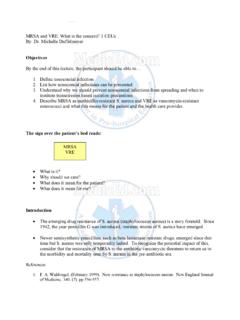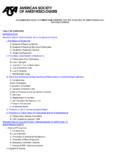Transcription of The Role of Manual Patient Turning in Preventing …
1 White Paper The Role of Manual Patient Turning in Preventing hospital acquired conditions Susan M. Kennerly, PhD, RN, WCC and Tracey L. Yap, PhD, RN, WCC, FAAN. Abstract Manual Turning of patients has many benefits beyond pressure ulcer prevention. It is the first step in early mobilization of bedbound patients to prevent cardiovascular and musculoskeletal effects of immobility, such as a change in muscle and/or bone mass and a reduction in plasma volume. Manual Turning also helps prevent gravitational equilibrium, which eventually makes it more difficult for the Patient to tolerate position changes.
2 Turning is a key component in prevention of pneumonia and post-operative fever and has been shown to lead to fewer ICU days and better Patient outcomes. Leaf Healthcare, Inc. The Role of Manual Patient Turning in Preventing hospital acquired conditions | White Paper Background The effects of prolonged immobility have been extensively Bedbound patients experience changes in muscle and bone mass, lung volumes, oxygen consumption, and are at increased risk for thromboembolism and pressure related skin problems. In addition, immobile patients can experience psychological stress associated with their condition.
3 Immobility and physical inactivity are risk factors in the development of pressure ulcers (Gillespie, Cochrane Review, 2014). While bed rest is a common and often necessary prescription for ICU patients,2 prolonged immobility may result in increased insulin resis- tance,3 reduction in plasma volume, increased cardiovascular workload, elevated resting heart rate and decreased stroke volume with a reduction in cardiac ,5 Numerous benefits reported as a result of progressively increasing mobility through Turning and repositioning include reduction in both hospital and ICU length of stays.
4 (Brindle, 2013). Every two hour Turning is The primary purpose of Patient Turning is to relieve pressure, improve Patient comfort considered standard of care and aid pulmonary secretions. Every two hour Turning is considered standard of care for for mobility impaired patients, however, there is inconsistency mobility impaired patients, however, there is inconsistency with much variation in the with much variation in the perfor- performance of Manual turns according to established ,7,8,9. mance of Manual turns according to established ,7,8,9. Prevent hospital acquired Pressure Ulcers Making sure that patients move regularly improves healing, while repositioning in bed and chair them helps relieve pressure on bony prominences and prevent pressure ,11,12,13.
5 The use of Continuous Lateral Patient Turning is the mainstay in national and international pressure ulcer prevention Rotation Therapy (CLRT) and The use of Continuous Lateral Rotation Therapy (CLRT) and alternating alternating pressure beds do not pressure beds do not effectively turn and reposition patients, since they do not remove the effectively turn and reposition patients, since they do not remove pressure from the skin. Use of lateral rotation therapy has not been found to be effective in the pressure from the skin. pressure ulcer prevention and should, therefore, not be used as a proxy to Manual Patient Improve Respiratory Function and Prevent Respiratory Infections Immobility exacerbates the accumulation of mucus in dependent lung zones.
6 Consequently, pooled secretions act as a nidus for bacterial proliferation culminating in respiratory Regular Turning helps reduce atelectasis and mobilizes lung secretions thereby reducing risk of respiratory tract Appropriate Turning and reposi- Appropriate Turning and repositioning of the critically ill Patient can also dramatically tioning of the critically ill Patient improve their gas exchange, resulting in a shorter stay in the critical care unit and an can also dramatically improve their improved A large observational study published in American Journal of Critical gas exchange, resulting in a shorter stay in the critical care unit and an Care19 showed that the more frequently a Patient is turned, the less likely pneumonia is to improved develop.
7 The authors concluded that even the most critically ill patients can tolerate and profit from a regular Turning schedule. In a separate study on stroke patients, Manual repositioning started within 48 hours of onset of ischemic stroke helped to reduce the incidence of nosocomial Page 2. Leaf Healthcare, Inc. The Role of Manual Patient Turning in Preventing hospital acquired conditions | White Paper Improve Outcomes in Cardiac Patients Manual Turning in the first 24 Manual Turning in the first 24 hours after coronary arterial bypass (CAB) surgery helps hours after coronary arterial bypass shorten ICU stays and provides savings in rental bed costs21, resulting in significant financial (CAB) surgery helps shorten ICU.
8 Stays and provides savings in rental savings to the hospital . Also, CAB patients who are turned systematically in the first 24. bed costs21, resulting in significant hours postoperatively have significantly fewer hours of postoperative fever than those who financial savings to the hospital . are immobilized after Prevent Orthostatic Intolerance in ICU Patients Therapeutic activity in the ICU begins with manually Turning the Patient from supine to lateral positions and initiating a range of motion (ROM) exercises that may progress to dangling, chair sitting and Turning ICU patients helps prevent orthostatic intolerance, which results from patients remaining in stationary position for extended periods of Patients who are left in a stationary position for prolonged periods of time will experience greater hemodynamic instability when Turning is eventually initiated.
9 To prevent orthostatic intolerance, a Turning schedule should be started within hours of ICU In burn units, using therapeutic positioning aids in reducing edema and preserving function by proper body alignment and use of anti-contracture Summary Manual Turning of patients has many benefits beyond pressure ulcer prevention. It is the first step in early mobilization of bedbound patients to prevent cardiovascular and musculoskeletal effects of immobility, such as loss of muscle mass, bone mass and plasma volume. Manual Turning also helps prevent gravitational equilibrium, which eventually makes it more difficult for the Patient to tolerate position changes.
10 Turning is a key component in prevention of pneumonia and post-operative fever and has been shown to lead to fewer ICU days and better Patient outcomes. Susan Kennerly is with the University of North Carolina Charlotte, School of Nursing. Her scholarship has identified how nursing can facilitate practices, such as repositioning, to prevent pressure ulcers. Tracey Yap of the Duke University School of Nursing has developed and tested approaches to improve care for institutionalized older adults at high risk for developing pressure ulcers. Page 3. Leaf Healthcare, Inc. The Role of Manual Patient Turning in Preventing hospital acquired conditions | White Paper References 1.

